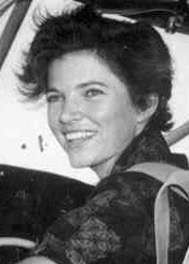
Home - Search - Browse - Alphabetic Index: 0- 1- 2- 3- 4- 5- 6- 7- 8- 9
A- B- C- D- E- F- G- H- I- J- K- L- M- N- O- P- Q- R- S- T- U- V- W- X- Y- Z
Allison, Rhea Hurrle nee Woltman
 Allison Credit: www.spacefacts.de |
Status: Inactive. Born: 1928.
School teacher and pilot. One of the group of women who went to the Lovelace Clinic in Albuquerque, New Mexico in 1961 and underwent the same medical and psychological tests that the Mercury 7 astronauts had completed. She was one of the Mercury 13 finalists, considered qualified by Dr. Lovelace for astronaut training.
Colorado State Biography: Rhea Hurrle Allison Woltman grew up in central Minnesota and attended St. Cloud Teacherís College. But she always wanted to fly, so after just a couple of years of teaching in a one-room schoolhouse, she moved to Texas and started training as a pilot. Starting with her first plane, a Piper J3, Woltman progressed from a private pilot to a commercial pilot, then earned her rating as an instructor for flying airplanes by instrument. Woltman eventually attained her C-plane rating for airplanes with floats and her rating as a glider pilot. She flew competitively, and she also completed one of the major flights of the era for women, a solo flight from Houston to Anchorage in a Piper Super Cub with floats.
In the early 1960s, the United States was engaged in The Space Race. Woltman was working as a charter pilot in Houston, having already logged almost 2,000 flight hours. She was tapped as one of the women to undergo testing to participate in the secret Mercury project, submitting to the same rigorous medical and physical tests as her male counterparts, from sensory deprivation to weightless training to scuba certification. Woltman and 12 other women pilots became the First Lady Astronaut Trainees (FLATS), now known as the Mercury 13. Woltman was prepared and eager to undertake space flight, but the Mercury 13 never reached their goal. The U.S. government shut down the womenís program without their ever being able to fly a space mission, but these women led the way for other American women to travel into space. In 2007, the University of Wisconsin conferred on Woltman and the remaining Mercury 13 astronauts an Honorary Doctorate in Aeronautics, honoring them as pioneers in aviation history.
Woltman moved to Colorado Springs in the early 1970s, where she did glider training and towing for Air Force Academy cadets at the Black Forest Glider Port. She grounded herself in order to participate in her husbandís business. Her interest in parliamentary procedure led her to become a professional Registered Parliamentarian, the highest level of proficiency in the field. She was the first parliamentarian for the U.S. Olympic Committee and has served many other organizations across the country as parliamentarian, including the Colorado Association of Hospital Auxiliaries.
More at: Allison.
Family: Astronaut. Country: USA. Bibliography: 4452.
1961 January 1 - .
- Mercury 13 Astronaut Training Group selected. - .
Nation: USA.
Related Persons: Allison,
Cagle, Myrtle,
Cobb,
Dietrich,
Dietrich, Marion,
Funk,
Gorelick,
Hart, Jane,
Hixson,
Leverton,
Steadman,
Stumough,
Truhill.
Qualifications: Qualified jet pilot with minimum 1,500 flight-hours/10 years experience, bachelor's degree or equivalent, under 40 years old, under 180 cm height, excellent physical condition.. Randolph Lovelace was director of the clinic where the Mercury astronauts had undergone their physical examinations. He and Jacqueline Cochran, the first American woman to break the sound barrier, wanted to prove that women were equally qualified to be astronauts. In early 1961 they arranged for 20 highly qualified female pilots to take the same physical tests undergone by the Mercury astronauts. Thirteen passed the tests, but NASA maintained its position that astronauts had to be qualified test pilots (all of whom were white males). One of the thirteen was the wife of a US Senator, and some congressional hearings were arranged. Despite the publicity NASA was still unwilling to place them in the official NASA training program.
Oddly enough, the selection of these women may have resulted in the first woman going into space after all. In May 1962 a Soviet delegation, including cosmonaut Gherman Titov and cosmonaut commander Nikolai Kamanin, visited Washington. Kamanin had been pushing for the flight of a Soviet woman into space since October 1961, and five Soviet female cosmonauts had just reported for training a month earlier. However the flight of a woman in space had little support from Chief Designer Korolev or Kamanin's military commanders. On May 3 Kamanin and Titov were invited to a barbecue at the home of astronaut John Glenn. Glenn, already politically-connected, was an enthusiastic supporter of the 'Lovelace 13'. Kamanin understood from Glenn that the first American woman would make a three-orbit Mercury flight by the end of 1962. Armed with the threat that 'the Americans will beat us', Kamanin was able to obtain a decision to go ahead with the first flight of a Soviet woman within weeks of his return. The Russians were obsessed with being first in space -- and even though NASA's female cosmonauts never materialised, Valentina Tereshkova of the Soviet Union became the first woman in space on June 16, 1963.
Back to top of page
Home - Search - Browse - Alphabetic Index: 0- 1- 2- 3- 4- 5- 6- 7- 8- 9
A- B- C- D- E- F- G- H- I- J- K- L- M- N- O- P- Q- R- S- T- U- V- W- X- Y- Z
© 1997-2019 Mark Wade - Contact
© / Conditions for Use